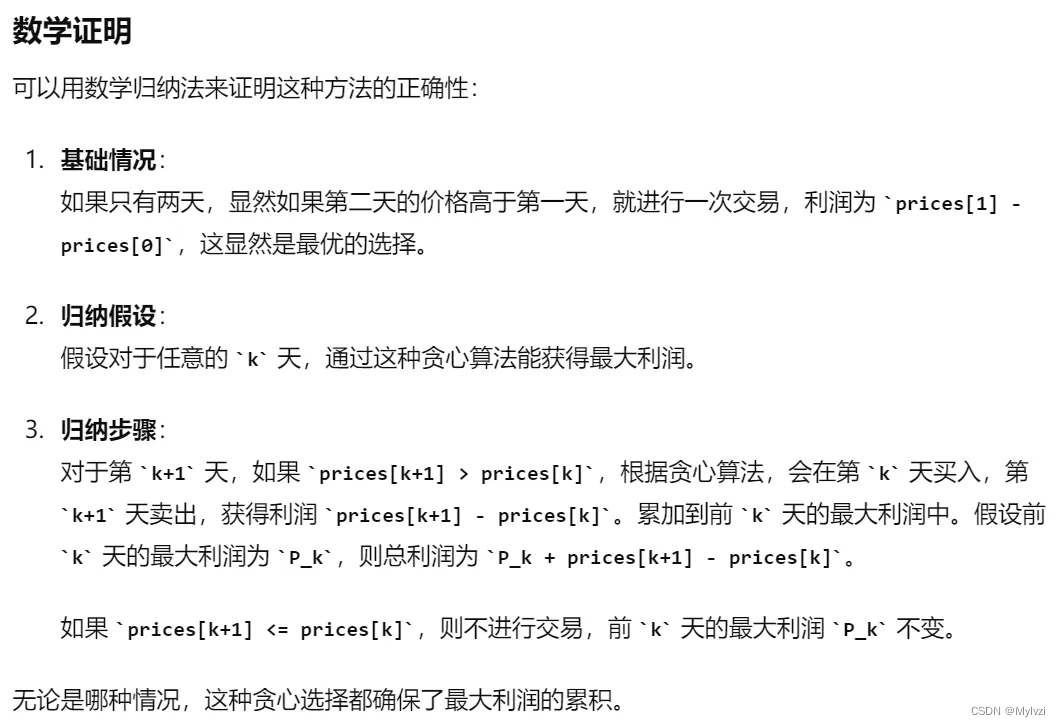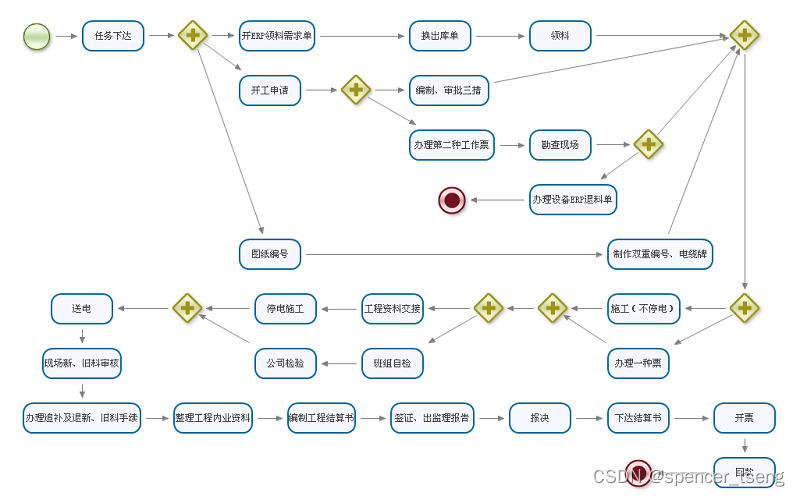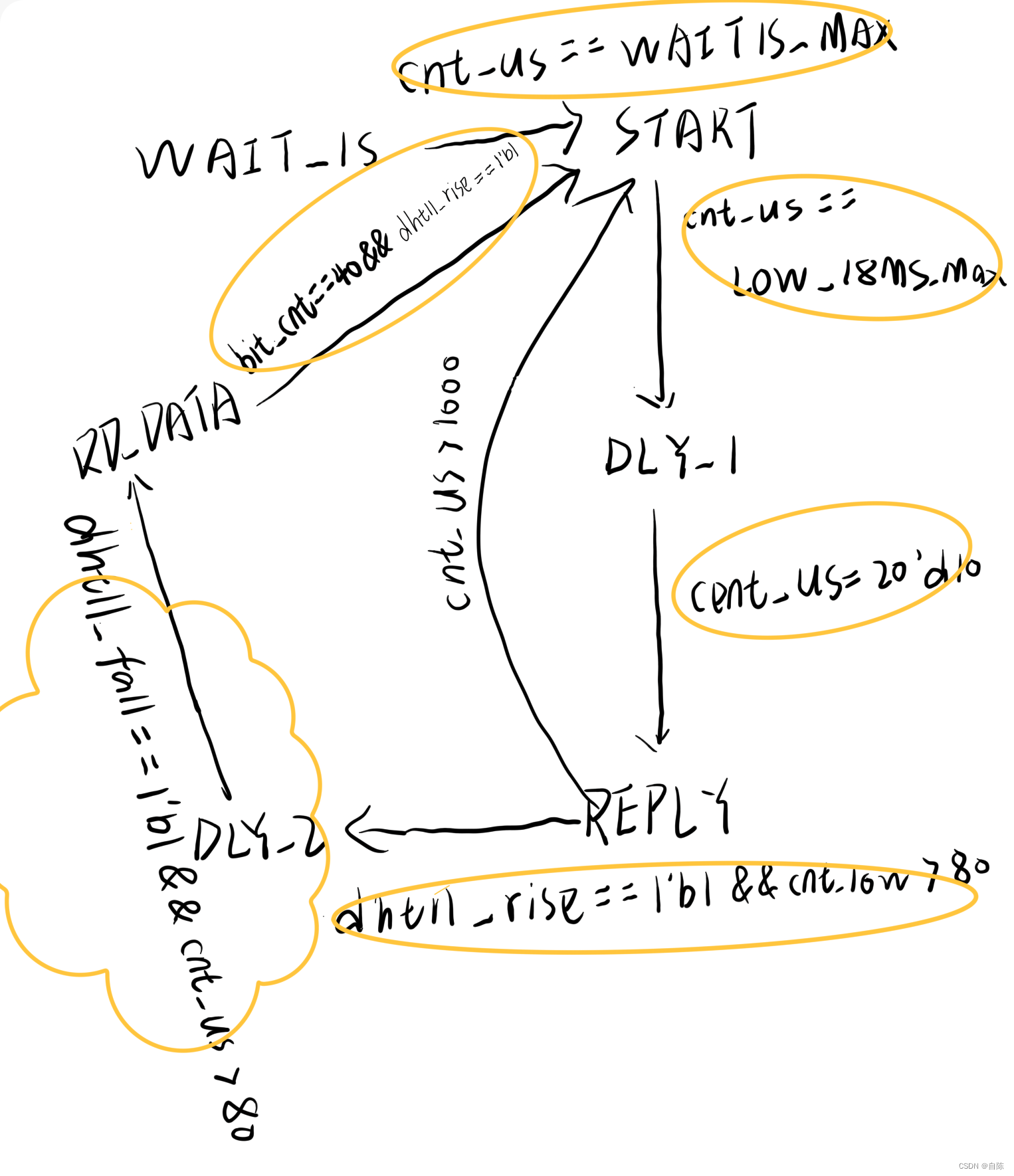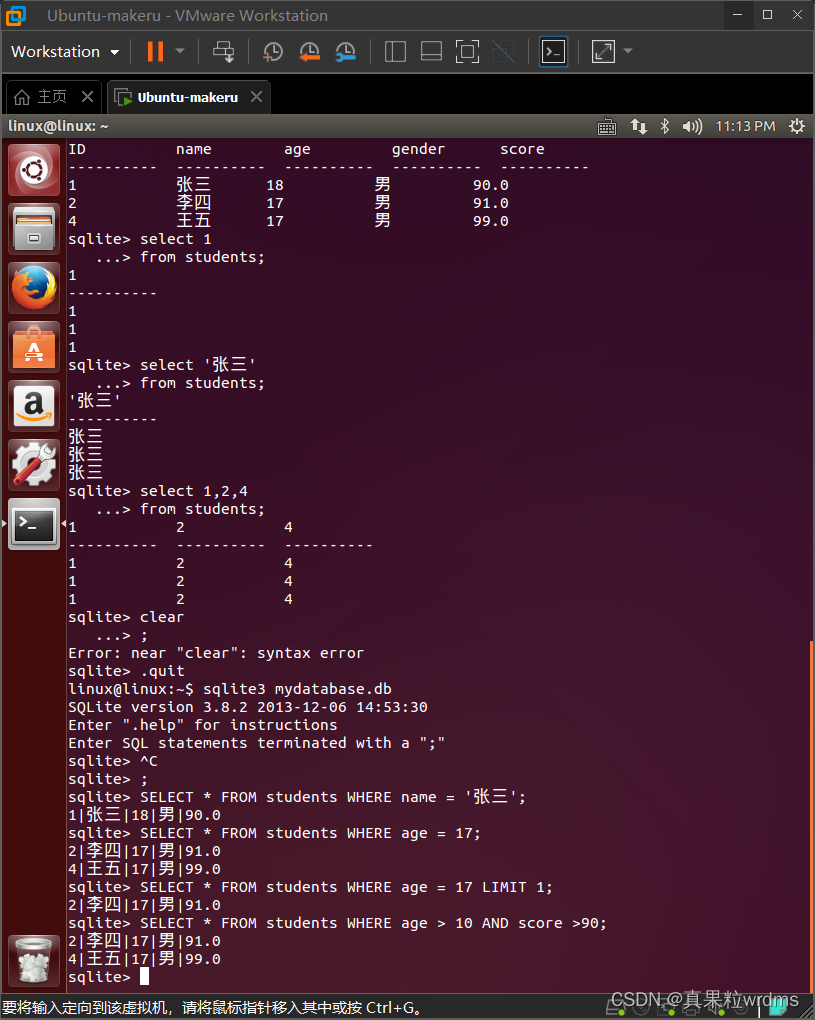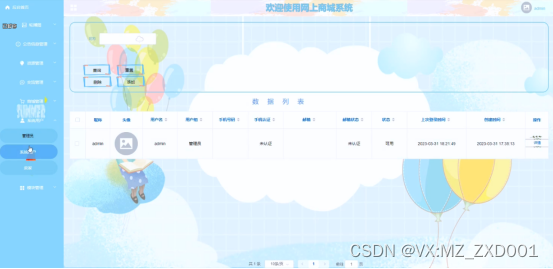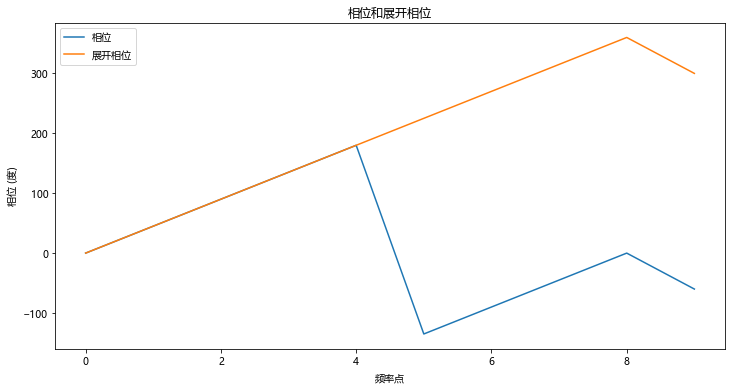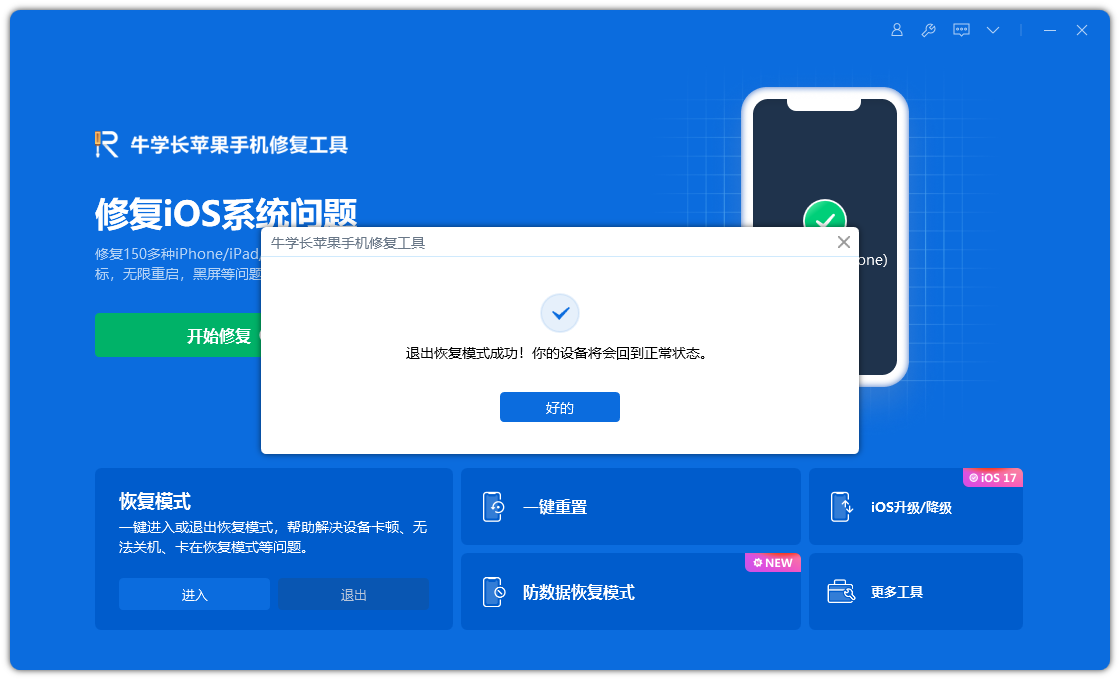利用CityScapes数据集,将其转换为COCO格式的实例分割数据集
– – – 进而再训练出新的YOLOv8-seg模型
写个前言:
人嘛,总想着偷点懒,有现成的数据集,就得拿来用,是吧?确实是这样。
接下来的步骤大概有这么几个,as follow.
S1:下载好cityscapes数据集【小的是带json的,大的是原图】
S2:将cityscapes转换为YOLO格式的JSON文件
S3:将此JSON文件转换为多个TXT文件【每个TXT对应自己的IMAGE】
S4:(根据需要,看看是不是自己要再加类别啥的)将这些个TXT文件转换成labelme对应的JSON文件
S5:(续S4)直接打开labelme,OK,至此和我的上一篇文章形成套环:
上一篇文章链接
S1:下载好cityscapes数据集【小的是带json的,大的是原图】


解压后,简单测试一个城市的,就比如Aachen:
分别把这俩数据集解压出来的Aachen城市的数据拿出来【我是分别单独给创建个dev测试目录存的】
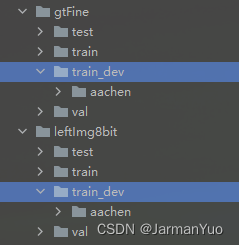
S2:将cityscapes转换为YOLO格式的JSON文件【transcityscapes2coco_dev.py】【随便放位置】
import sys
if "/opt/ros/kinetic/lib/python2.7/dist-packages" in sys.path:
sys.path.remove("/opt/ros/kinetic/lib/python2.7/dist-packages")
import cv2
import json
import os
from PIL import Image
import numpy as np
from pycococreatortools import pycococreatortools
ROOT_DIR = 'C:/Users/ycc/Desktop/cityscapes2coco-master/cityscape'
IMAGE_DIR = os.path.join(ROOT_DIR, "leftImg8bit/train_dev")
ANNOTATION_DIR = os.path.join(ROOT_DIR, "gtFine/train_dev")
ANNOTATION_SAVE_DIR = os.path.join(ROOT_DIR, "annotations") # annotations是新创建的
INSTANCE_DIR = os.path.join(ROOT_DIR, "gtFine/train_dev")
IMAGE_SAVE_DIR = os.path.join(ROOT_DIR, "val_images") # train_images是新创建的
INFO = {
"description": "Cityscapes_Instance Dataset",
"url": "https://github.com/waspinator/pycococreator",
"version": "0.1.0",
"year": "2020",
"contributor": "Kevin_Jia",
"date_created": "2020-1-23 19:19:19.123456"
}
LICENSES = [
{
"id": 1,
"name": "Attribution-NonCommercial-ShareAlike License",
"url": "http://creativecommons.org/licenses/by-nc-sa/2.0/"
}
]
CATEGORIES = [
{
'id': 1,
'name': 'car',
'supercategory': 'cityscapes',
},
{
'id': 2,
'name': 'pedestrian',
'supercategory': 'cityscapes',
},
{
'id': 3,
'name': 'truck',
'supercategory': 'cityscapes',
},
{
'id': 4,
'name': 'bus',
'supercategory': 'cityscapes',
},
{
'id': 5,
'name': 'rider',
'supercategory': 'cityscapes',
},
{
'id': 6,
'name': 'caravan',
'supercategory': 'cityscapes',
},
{
'id': 7,
'name': 'motorcycle',
'supercategory': 'cityscapes',
},
{
'id': 8,
'name': 'bicycle',
'supercategory': 'cityscapes',
}
]
background_label = list(range(-1, 24, 1)) + [30, 31, 34]
idx = 0
pic_scale = 1.0
h_bias = 1.0
def image_trans():
img_subfolders = os.listdir(IMAGE_DIR)
image_count = 0
for sub in img_subfolders:
# sub_path = sub + '/' + sub
image_sub_path = os.path.join(IMAGE_DIR, sub)
for image in os.listdir(image_sub_path):
img_path = os.path.join(image_sub_path, image)
ann_name = image.split('_')[0] + '_' + image.split('_')[1] + '_' + image.split('_')[
2] + '_gtFine_instanceIds.png'
ann_sub_path = os.path.join(ANNOTATION_DIR, sub)
ann_path = os.path.join(ann_sub_path, ann_name)
if os.path.exists(ann_path):
pic = cv2.imread(img_path)
h, w = pic.shape[:2]
new_w = w * pic_scale
new_h = new_w / 2
top = int((h_bias * h - new_h) / 2)
bottom = int((h_bias * h + new_h) / 2)
left = int((w - new_w) / 2)
right = int((w + new_w) / 2)
roi = pic[top:bottom, left:right]
img_save_path = os.path.join(IMAGE_SAVE_DIR, image)
cv2.imwrite(img_save_path, roi)
annotation = cv2.imread(ann_path, -1)
ann_roi = annotation[top:bottom, left:right]
ann_save_path = os.path.join(ANNOTATION_SAVE_DIR, ann_name)
cv2.imwrite(ann_save_path, ann_roi)
else:
print(image + ' do not have instance annotation')
print(image_count)
image_count += 1
def data_loader():
imgs = os.listdir(IMAGE_SAVE_DIR)
masks_generator(imgs, ANNOTATION_SAVE_DIR)
def masks_generator(imges, ann_path):
global idx
pic_count = 0
for pic_name in imges:
image_name = pic_name.split('.')[0]
ann_folder = os.path.join(INSTANCE_DIR, image_name)
os.mkdir(ann_folder)
annotation_name = pic_name.split('_')[0] + '_' + pic_name.split('_')[1] + '_' + pic_name.split('_')[
2] + '_gtFine_instanceIds.png'
# annotation_name = image_name + '_instanceIds.png'
print(annotation_name)
annotation = cv2.imread(os.path.join(ann_path, annotation_name), -1)
h, w = annotation.shape[:2]
ids = np.unique(annotation)
for id in ids:
if id in background_label:
continue
else:
class_id = id // 1000
if class_id == 26:
instance_class = 'car'
elif class_id == 24:
instance_class = 'pedestrian'
elif class_id == 27:
instance_class = 'truck'
elif class_id == 28:
instance_class = 'bus'
elif class_id == 25:
instance_class = 'rider'
elif class_id == 29:
instance_class = 'caravan'
elif class_id == 32:
instance_class = 'motorcycle'
elif class_id == 33:
instance_class = 'bicycle'
else:
continue
instance_mask = np.zeros((h, w, 3), dtype=np.uint8)
mask = annotation == id
instance_mask[mask] = 255
mask_name = image_name + '_' + instance_class + '_' + str(idx) + '.png'
cv2.imwrite(os.path.join(ann_folder, mask_name), instance_mask)
idx += 1
pic_count += 1
print(pic_count)
def json_generate():
car = 0
pedestrian = 0
truck = 0
bus = 0
rider = 0
caravan = 0
motorcycle = 0
bicycle = 0
files = os.listdir(IMAGE_SAVE_DIR)
coco_output = {
"info": INFO,
"licenses": LICENSES,
"categories": CATEGORIES,
"images": [],
"annotations": []
}
image_id = 1
segmentation_id = 1
# go through each image
for image_filename in files:
image_name = image_filename.split('.')[0]
image_path = os.path.join(IMAGE_SAVE_DIR, image_filename)
image = Image.open(image_path)
image_info = pycococreatortools.create_image_info(
image_id, os.path.basename(image_filename), image.size)
coco_output["images"].append(image_info)
print(image_filename)
annotation_sub_path = os.path.join(INSTANCE_DIR, image_name)
ann_files = os.listdir(annotation_sub_path)
if len(ann_files) == 0:
print("ao avaliable annotation")
continue
else:
for annotation_filename in ann_files:
annotation_path = os.path.join(annotation_sub_path, annotation_filename)
for x in CATEGORIES:
if x['name'] in annotation_filename:
class_id = x['id']
break
# class_id = [x['id'] for x in CATEGORIES if x['name'] in annotation_filename][0]
if class_id == 1:
car += 1
elif class_id == 2:
pedestrian += 1
elif class_id == 3:
truck += 1
elif class_id == 4:
bus += 1
elif class_id == 5:
rider += 1
elif class_id == 6:
caravan += 1
elif class_id == 7:
motorcycle += 1
elif class_id == 8:
bicycle += 1
else:
print('illegal class id')
category_info = {'id': class_id, 'is_crowd': 'crowd' in image_filename}
binary_mask = np.asarray(Image.open(annotation_path)
.convert('1')).astype(np.uint8)
annotation_info = pycococreatortools.create_annotation_info(
segmentation_id, image_id, category_info, binary_mask,
image.size, tolerance=2)
if annotation_info is not None:
coco_output["annotations"].append(annotation_info)
segmentation_id = segmentation_id + 1
image_id = image_id + 1
print(image_id)
with open('{}/val_modified.json'.format(ROOT_DIR), 'w') as output_json_file:
json.dump(coco_output, output_json_file)
print(car, pedestrian, truck, bus, rider, caravan, motorcycle, bicycle)
if __name__ == "__main__":
image_trans()
data_loader()
json_generate()
执行代码结束后,得到:val_modified.json【和你的数据集同目录】
Ctrl+Alt+L格式化一下JSON,好看一些。
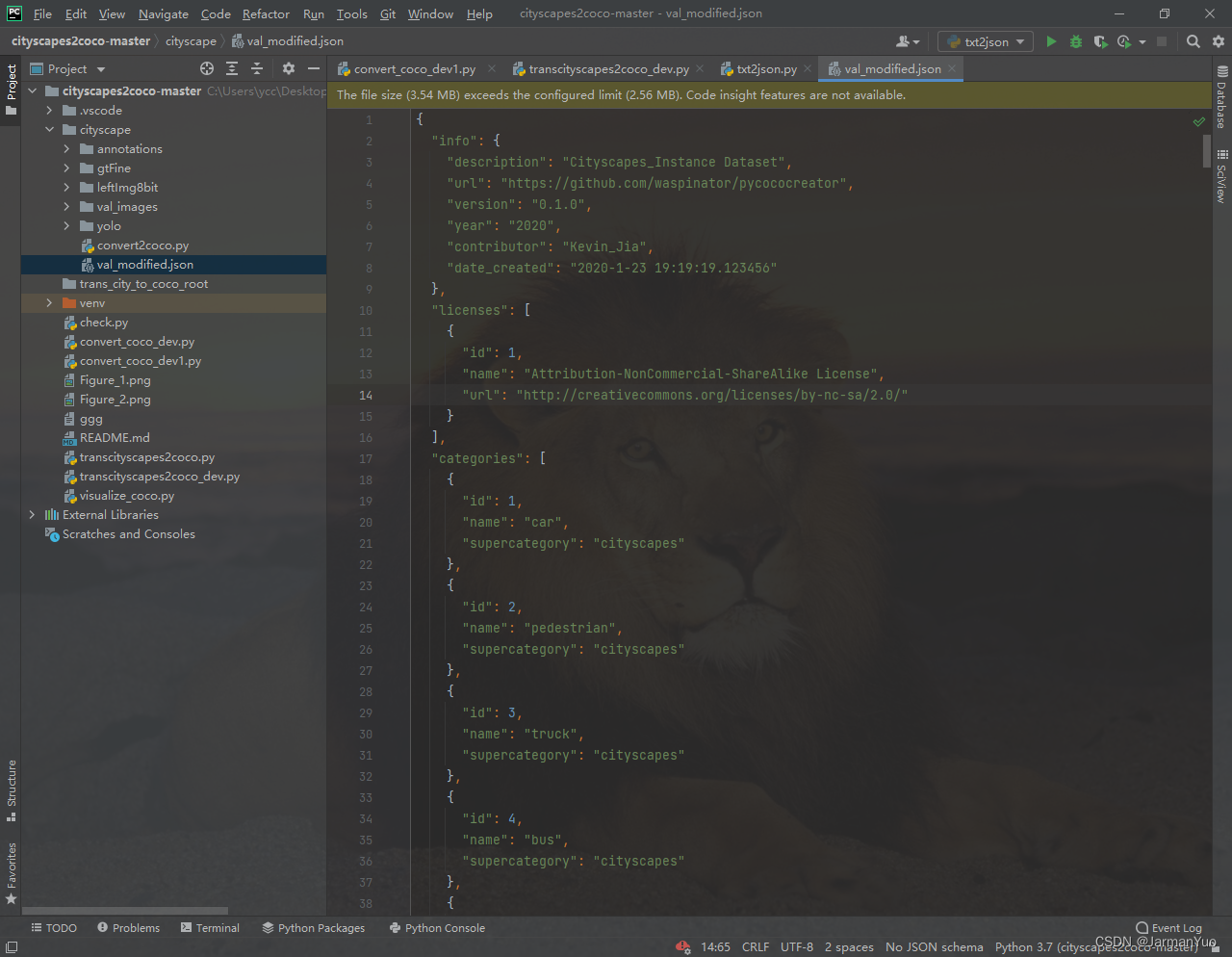
S3:将此JSON文件转换为多个TXT文件【每个TXT对应自己的IMAGE**】**
【convert_coco_dev1.py】【随便放个地方】【注释掉的部分,是detect转换,不动代码的话,就是seg转换】
import json
import os
def convert_coco_to_yolo(coco_data):
image_list = coco_data['images']
annotations = coco_data['annotations']
categories = coco_data['categories']
yolo_data = []
category_dict = {} # 用于存储类别名和对应的序号
for i, category in enumerate(categories): # 构建类别名和序号的映射关系
category_dict[category['name']] = i
for image in image_list:
image_id = image['id']
file_name = image['file_name']
width = image['width']
height = image['height']
image_annotations = [ann for ann in annotations if ann['image_id'] == image_id]
yolo_annotations = []
for ann in image_annotations:
category_id = ann['category_id']
category = next((cat for cat in categories if cat['id'] == category_id), None)
if category is None:
continue
# bbox = ann['bbox']
# x, y, w, h = bbox
# x_center = x + w / 2
# y_center = y + h / 2
# normalized_x_center = x_center / width
# normalized_y_center = y_center / height
# normalized_width = w / width
# normalized_height = h / height
# 实例分割代码:
segmentation = ann['segmentation']
yolo_annotations.append({
'category': category_dict[category['name']], # 使用类别序号
'seg': [site for site in segmentation]
})
# yolo_annotations.append({
# 'category': category_dict[category['name']], # 使用类别序号
# 'x_center': normalized_x_center,
# 'y_center': normalized_y_center,
# 'width': normalized_width,
# 'height': normalized_height
# })
if yolo_annotations:
yolo_annotations.sort(key=lambda x: x['category']) # 按类别序号排序
yolo_data.append({
'file_name': file_name,
'width': width,
'height': height,
'annotations': yolo_annotations
})
return yolo_data, category_dict
path = 'C:/Users/ycc/Desktop/cityscapes2coco-master/cityscape' # 修改为包含 via_export_coco.json 文件的目录路径
file_name = 'val_modified.json' # 文件名
save_dir = 'C:/Users/ycc/Desktop/cityscapes2coco-master/cityscape/yolo/labels' # 保存目录
file_path = os.path.join(path, file_name) # 完整文件路径
if os.path.isfile(file_path): # 检查文件是否存在
with open(file_path, 'r', encoding='utf-8') as load_f:
load_dict = json.load(load_f)
yolo_data, category_dict = convert_coco_to_yolo(load_dict)
os.makedirs(save_dir, exist_ok=True) # 创建保存目录
# 生成 class.txt 文件
class_file_path = os.path.join(save_dir, 'classes.txt')
with open(class_file_path, 'w', encoding='utf-8') as class_f:
for category_name, category_index in sorted(category_dict.items(), key=lambda x: x[1]):
class_f.write(f"{category_name}\n")
for data in yolo_data:
file_name = os.path.basename(data['file_name']) # 提取文件名部分
width = data['width']
height = data['height']
annotations = data['annotations']
txt_file_path = os.path.join(save_dir, os.path.splitext(file_name)[0] + '.txt')
with open(txt_file_path, 'w', encoding='utf-8') as save_f:
for annotation in annotations:
category = annotation['category']
#实例分割代码
segmentation = annotation['seg']
line = f"{category}"
tem = ""
for s in segmentation:
tem = " ".join([f"{num:.6f}" for num in s])
line = line + " " + tem + "\n"
# x_center = annotation['x_center']
# y_center = annotation['y_center']
# box_width = annotation['width']
# box_height = annotation['height']
# line = f"{category} {x_center:.6f} {y_center:.6f} {box_width:.6f} {box_height:.6f}\n"
save_f.write(line)
print("转换完成,保存到:", save_dir)
else:
print("文件不存在:", file_path)
执行完之后,得到:labels【保存目录自己改,随你】

S4:(根据需要,看看是不是自己要再加类别啥的)将这些个TXT文件转换成labelme对应的JSON文件【不需要改动的话,就可以直接拿去训练YOLOv8-seg模型了,训练教程参考我的上一篇文章,链接在本文开头】
【txt2json.py】
import os
import cv2
import json
import glob
import numpy as np
def convert_txt_to_labelme_json(txt_path, image_path, output_dir, image_fmt='.jpg'):
# txt 转labelme json
txts = glob.glob(os.path.join(txt_path, "*.txt"))
for txt in txts:
labelme_json = {
'version': '4.5.7',
'flags': {},
'shapes': [],
'imagePath': None,
'imageData': None,
'imageHeight': None,
'imageWidth': None,
}
txt_name = os.path.basename(txt)
image_name = txt_name.split(".")[0] + image_fmt
labelme_json['imagePath'] = image_name
image_name = os.path.join(image_path, image_name)
if not os.path.exists(image_name):
raise Exception('txt 文件={},找不到对应的图像={}'.format(txt, image_name))
image = cv2.imdecode(np.fromfile(image_name, dtype=np.uint8), cv2.IMREAD_COLOR)
h, w = image.shape[:2]
labelme_json['imageHeight'] = h
labelme_json['imageWidth'] = w
with open(txt, 'r') as t:
lines = t.readlines()
for line in lines:
content = line.split(' ')
label = content[0]
shape = {
'label': str(label),
'flags': {},
'points': []
}
for i in range(len(content)):
if 2 * i + 1 >= len(content):
break
else:
try:
shape['points'].append([float(content[2 * i + 1]), float(content[2 * i + 2])])
except Exception as e:
print(e)
labelme_json['shapes'].append(shape)
json_name = txt_name.split('.')[0] + '.json'
json_name_path = os.path.join(output_dir, json_name)
fd = open(json_name_path, 'w')
json.dump(labelme_json, fd, indent=4)
fd.close()
print("save json={}".format(json_name_path))
if __name__=="__main__":
in_imgs_dir = 'C:\\Users\\ycc\\Desktop\\cityscapes2coco-master\\cityscape\\leftImg8bit\\train_dev\\aachen'
in_label_txt_dir = 'C:\\Users\\ycc\\Desktop\\cityscapes2coco-master\\cityscape\\yolo\\labels'
out_labelme_json_dir = 'C:\\Users\\ycc\\Desktop\\cityscapes2coco-master\\cityscape\\yolo\\json'
if not os.path.exists(out_labelme_json_dir):
os.mkdir(out_labelme_json_dir)
convert_txt_to_labelme_json(in_label_txt_dir,in_imgs_dir,out_labelme_json_dir,image_fmt='.png')
执行完之后得到JSON:
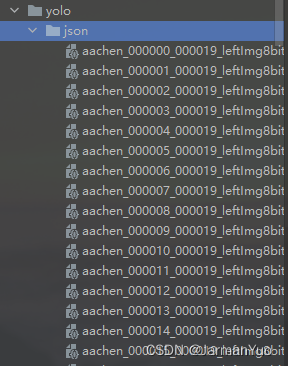
OK,至此,再将得到的JSON文件和image原图片文件放到一个文件夹下(对应的名字都一样,一份对应一个png一个json)如下:

然后直接labelme打开这个目录就好了,开始编辑自己的数据集吧,we go…

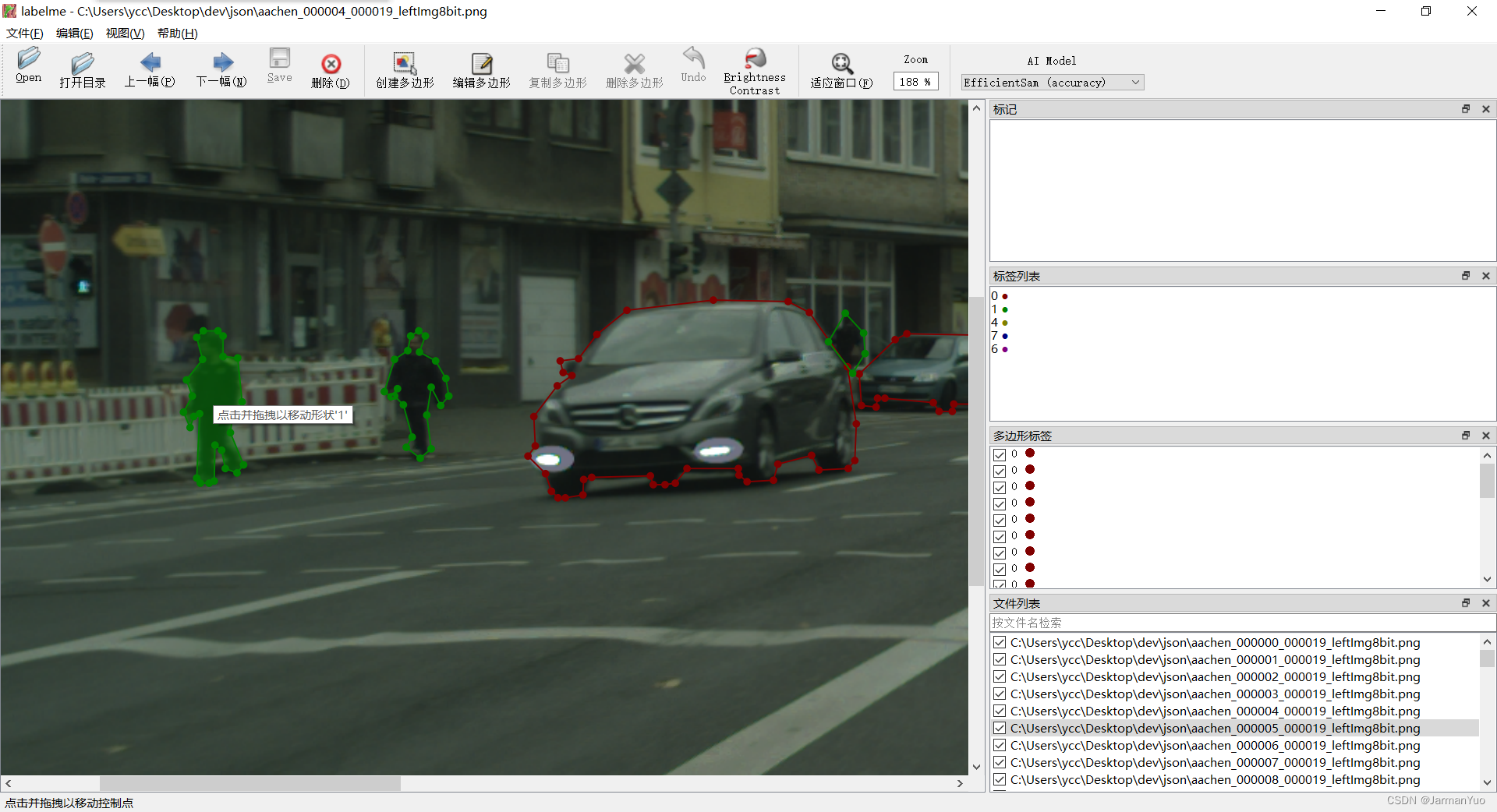
提一嘴,标签的名字整成数字了,不过能区分不同类别,问题是出在TXT转JSON这一步上,后边再更新,wait for me!


